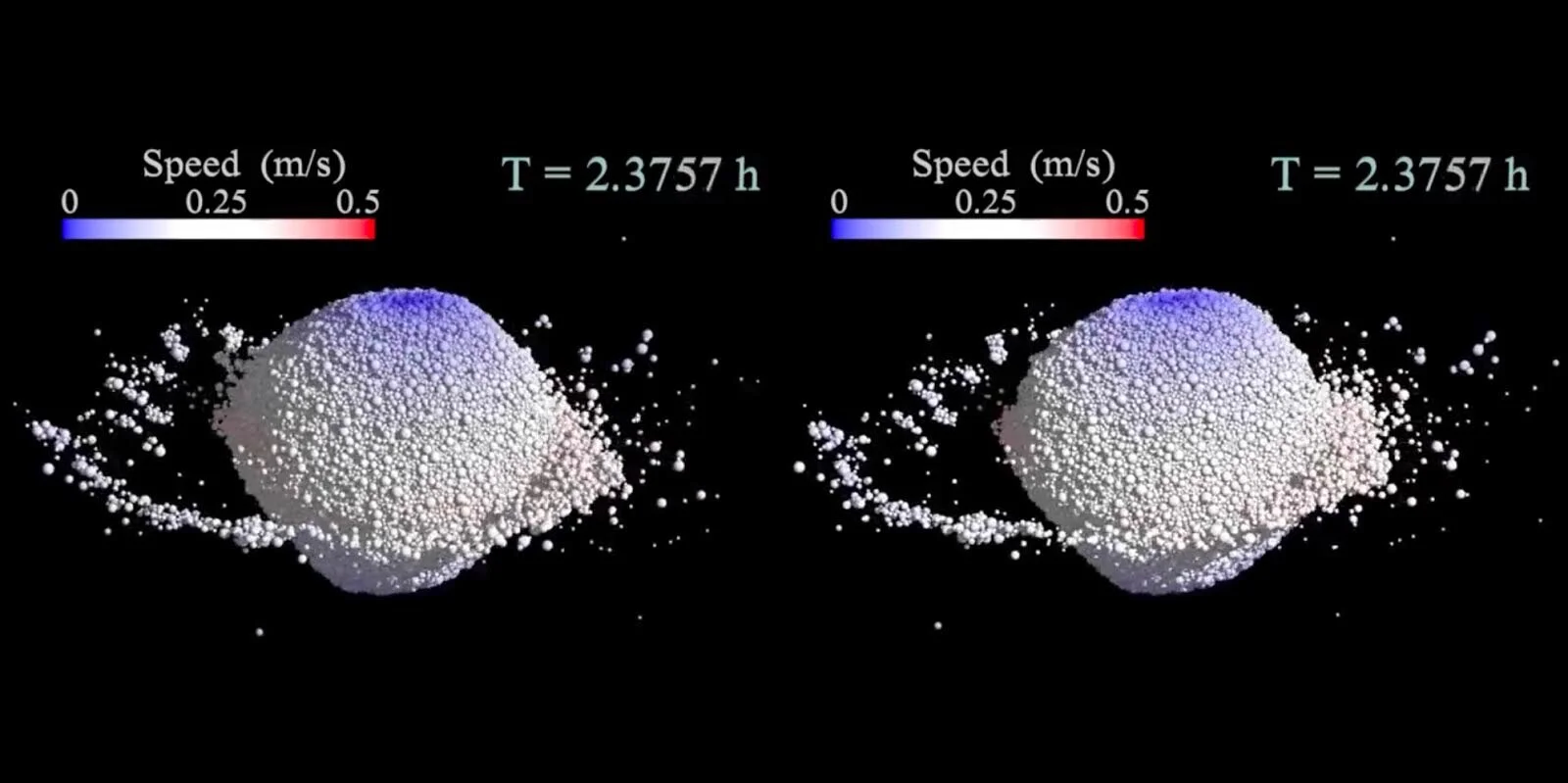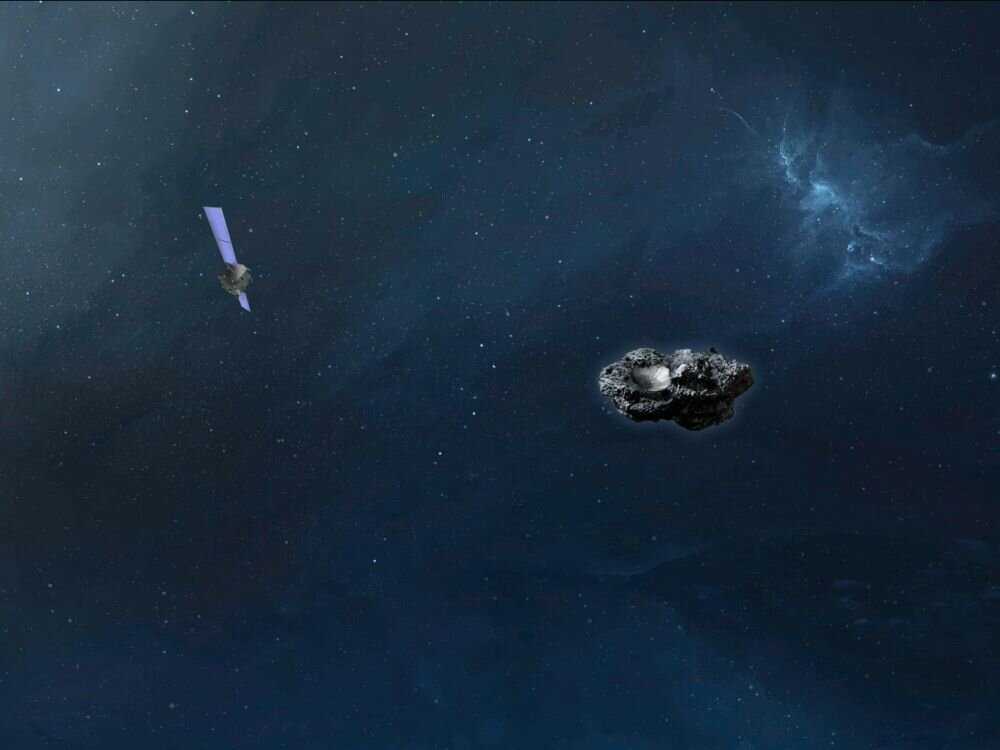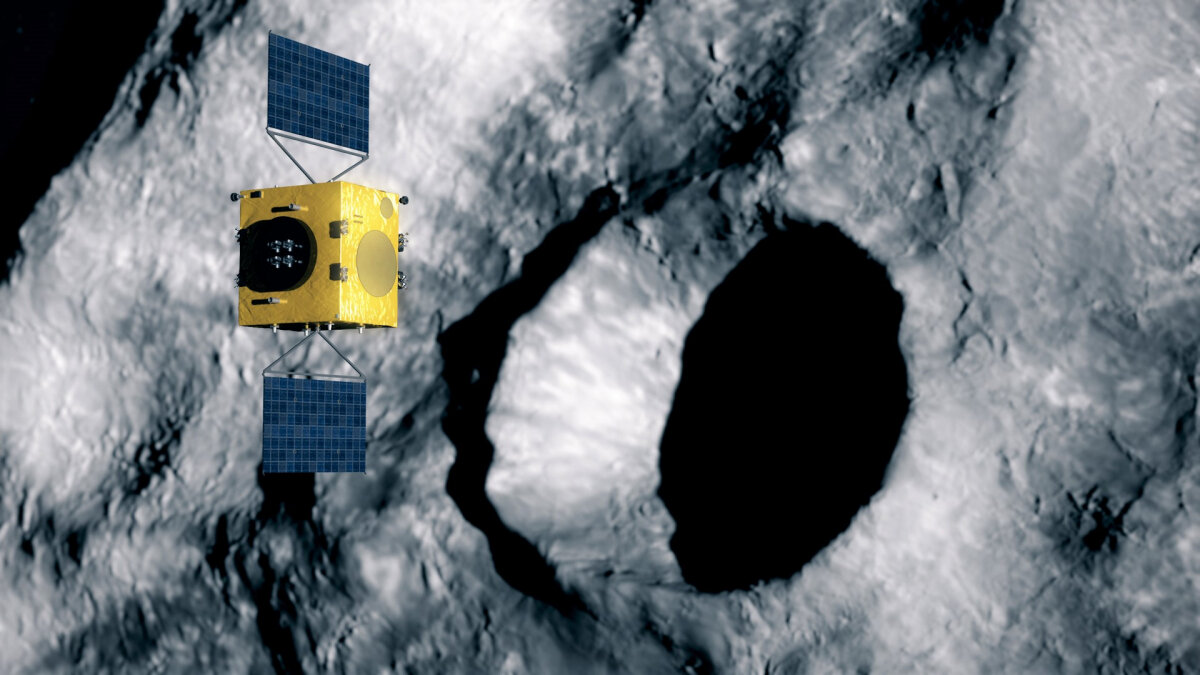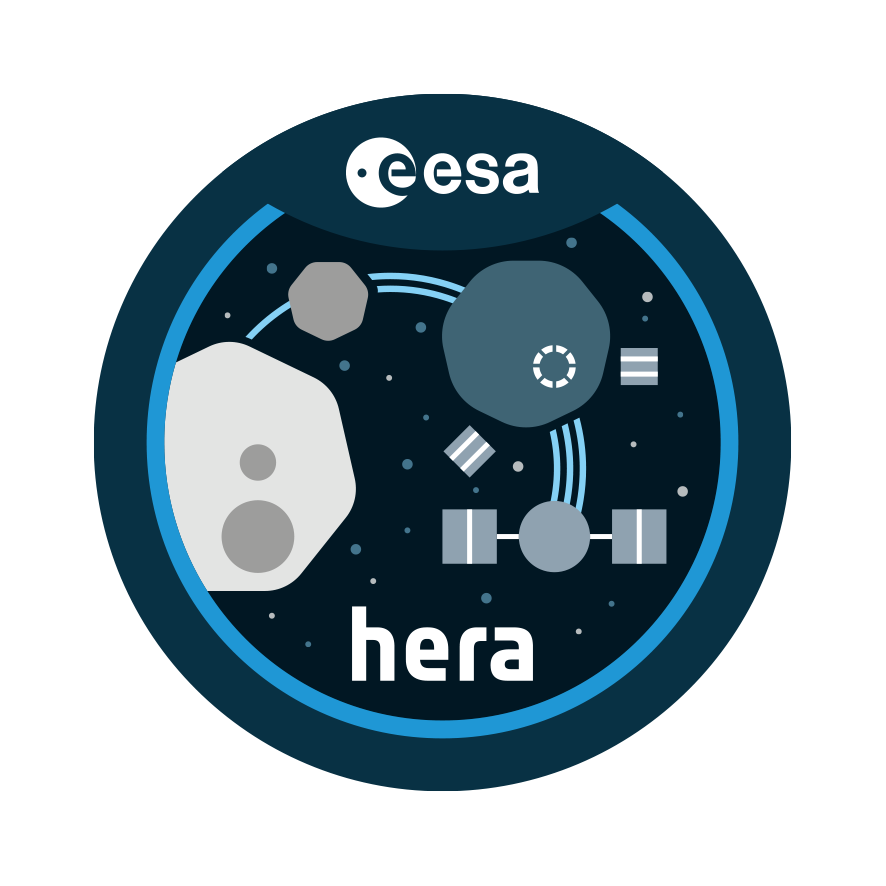
🇬🇧 First Glimpses at Mars and Deimos: Hera Mission Receives Imagery at ESOC
Hera 's successful flyby of Mars on March 12, 2025, marked a pivotal milestone with the reception of its first images of Mars and its enigmatic moon, Deimos. Captured by Hera's advanced camera systems, these images provide unprecedented visual insights to calibrate instruments, optimize trajectory and possibly get new science knowledge. At the European Space Operations Centre (ESOC) in Darmstadt, Germany, the Hera science team, led by Principal Investigator Dr. Patrick Michel, celebrated this achievement and acknowledged the great work done by ESA Hera Operation Team. Joining him were astrophysicist Sir Dr. Brian May and other esteemed researchers, including Hera instrument leads, adding a unique blend of scientific expertise and passion. As Hera continues its interplanetary journey, these images lay the foundation for further understanding of asteroid systems, reinforcing the mission's dedication to advancing planetary defense technology.
Illustration by pro photographer Max Alexander, highlighting the collaboration and excitement surrounding this amazing achievement.

🇫🇷 La sonde Hera à l'approche de Mars et de Deimos
Rendez-vous le 22 mars 2025 à 14h30 au Centre Universitaire Méditerranéen, sur la Promenades des Anglais, à Nice (France) afin d’assister à la conférence de vulgarisation, en français, menée par les francophones de l'équipe scientifique de la mission spatiale européenne Hera de défense planétaire, alors même que la sonde sera dans l'environnement immédiat de la planète Mars. Des images inédites d'une de ses deux lunes, Deimos, seront dévoilées pour l'occasion.
Cet évènement est co-organisé par l’Agence Spatiale Européenne - ESA, l’Observatoire de la Côte d’Azur - OCA, l’Université Côte d’Azur - UniCA, le Centre Nationale de la Recherche Scientifique - CNRS et la Délégation à la culture scientifique de la Ville de Nice.

🇫🇷 L'équipe scientifique de Hera après le lancement de Hera, à Cap Canaveral
Après le lancement réussi de la mission Hera et les premières images de la Terre et de la Lune fournies par les caméras de la sonde, qui fonctionne magnifiquement et se trouve déjà dans l'espace lointain, avec plusieurs charges utiles déjà opérationnelles, le directeur général de l'ESA s'est lui-même félicité du développement de Hera en un temps record, alors qu'il se trouvait à l'IAC 2024 à Milan. En effet, ce projet de 4 ans, pour un budget inférieur à celui demandé, était une « première ». Le Principal Investigateur de Hera, Patrick Michel, espère que la structure que nous avons utilisée pour le projet Hera, une équipe intégrée mélangeant l'équipe scientifique avec le P.I., l'équipe de projet de l'ESA, et les industries, inspirera le programme scientifique car le lancement de Hera vient en effet d’en démontrer son efficacité ! Alors que le voyage cosmique de Hera commence, nous nous engageons à impliquer tous les passionnés de ces aventures spatiales, d’apporter des surprises, des découvertes, en particulier aux plus jeunes, pour les former et en faire les prochains acteurs et responsables de l'exploration spatiale.
Plus d'informations ici : https://www.esa.int/Space_Safety/Hera/Planetary_defence_mission_Hera_heading_for_deflected_asteroid

🇬🇧 The Hera Science Team after the Hera launch, at Cape Canaveral
After the successful launch of the Hera mission and the first images of the Earth and the Moon provided by the cameras of the probe, which is working magnificently and already in deep space, with several payloads already work-proof, the Director General of ESA himself welcomed the development of Hera in record time, while at the IAC 2024 in Milan. Indeed, this 4 years project, for a budget lower than requested, was a “first”. The Hera Principal investigator, Patrick Michel, hopes that the structure we used for the Hera project, an integrated team mixing scientific team with PI, ESA project team, and industries, will inspire the scientific program as the launch of Hera has indeed just demonstrated its effectiveness! While Hera’s cosmic trip begins, we are committed to involve all people passionate about these space adventures, their surprises, their discoveries, and particularly the youngest, to train them and make them the next actors and leaders of space exploration.
More here: https://www.esa.int/Space_Safety/Hera/Planetary_defence_mission_Hera_heading_for_deflected_asteroid

🇫🇷 Des aperçus des astéroïdes ciblés par Hera inspirent de nouvelles recherches scientifiques
La mission de défense planétaire Hera, de l'ESA, achève ses essais de pré-lancement et vise l'astéroïde Didymos et sa lune Dimorphos, de véritables mondes à l'échelle miniature (cf. la photographie, avec crédits NASA / Johns Hopkins University APL).
Dans un numéro spécial de Nature Communications daté du 31 juillet 2024 ont été publié 5 articles présentant des études de cet astéroïde binaire. Ces travaux, auxquels ont participé les membres de l'équipe scientifique de la mission Hera, sont fondés sur les quelque cinq minutes et demie d'images rapprochées renvoyées par le vaisseau spatial DART de la NASA avant qu'il ne percute volontairement Dimorphos, ainsi que sur les images post-impact du microsatellite LiciaCube de l'agence spatiale italienne.
Pour en savoir plus, suivez ce lien (en anglais) vers le site webb de l'ESA:
https://www.esa.int/Space_Safety/Hera/Glimpses_of_Hera_s_target_asteroids_inspire_new_science

🇬🇧 Recent collisional history of (65803) Didymos (Nature Communications, open access)
The Double Asteroid Redirection Test (DART, NASA) spacecraft revealed that the primary of the (65803) Didymos near-Earth asteroid (NEA) binary system is not exactly the expected spinning top shape observed for other km-size asteroids. Ground based radar observations predicted that such shape was compatible with the uncertainty along the direction of the asteroid spin axis. Indeed, Didymos shows crater and landslide features, and evidence for boulder motion at low equatorial latitudes. Altogether, the primary seems to have undergone sudden structural failure in its recent history, which may even result in the formation of the secondary. The high eccentricity of Didymos sets its aphelion distance inside the inner main belt, where it spends more than 1/3 of its orbital period and it may undergo many more collisions than in the NEA region. In this work, we investigate the collisional environment of this asteroid and estimate the probability of collision with multi-size potential impactors. We analyze the possibility that such impacts produced the surface features observed on Didymos by comparing collisional intervals with estimated times for surface destabilization by the Yarkovsky-O’Keefe-Radzievskii-Paddack (YORP) effect. We find that collisional effects dominate over potential local or global deformation due to YORP spin up.

🇬🇧 Physical properties of asteroid Dimorphos as derived from the DART impact (Nature Astronomy, open access)
On 26 September 2022, NASA’s Double Asteroid Redirection Test (DART) mission successfully impacted Dimorphos, the natural satellite of the binary near-Earth asteroid (65803) Didymos. Numerical simulations of the impact provide a means to find the surface material properties and structures of the target that are consistent with the observed momentum deflection efficiency, ejecta cone geometry and ejected mass. Our simulation that best matches the observations indicates that Dimorphos is weak, with a cohesive strength of less than a few pascals, like asteroids (162173) Ryugu and (101955) Bennu. We find that the bulk density of Dimorphos is lower than ~2,400 kg m−3 and that it has a low volume fraction of boulders (≲40 vol%) on the surface and in the shallow subsurface, which are consistent with data measured by the DART experiment. These findings suggest that Dimorphos is a rubble pile that might have formed through rotational mass shedding and reaccumulation from Didymos. Our simulations indicate that the DART impact caused global deformation and resurfacing of Dimorphos. ESA’s upcoming Hera mission may find a reshaped asteroid rather than a well-defined crater.
https://www.nature.com/articles/s41550-024-02200-3

🇬🇧 NASA DART results: Cover of the journal Nature (CRASH COURSE, Volume 616 Issue 7957, 20 April 2023)
The NASA DART first results have just did the cover of the journal Nature. Hera mission team members were among the scientists doing the cover of the international scientific journal Nature about the NASA’s Double Asteroid Redirection Test (a.k.a. DART) space mission’s scientific results. Three of the five open-access papers published in the journal Nature presenting the first results of the NASA DART mission acknowledge support from the European Space Agency. These papers made the cover of the journal on its 20 April 2023 issue.
Extract: “Although currently there is no known threat to Earth from asteroids, strategies to protect the planet from a collision are being explored. On 26 September 2022, NASA and the Johns Hopkins Applied Physics Laboratory successfully tested one such approach: the Double Asteroid Redirection Test (DART) spacecraft was deliberately crashed into Dimorphos, a moon orbiting the small asteroid Didymos, resulting in a change in the moon’s orbit. In this week’s issue, five papers explore the test and the effects of the collision. One paper reconstructs the impact; a second looks at the change to Dimorphos’s orbit caused by the impact. A third paper reports observations from the Hubble Space Telescope of the material ejected during the collision. A fourth paper uses modelling to characterize the transfer of momentum that resulted from the impact. And the final paper reports on citizen science observations before, during and after the collision.”
https://www.nature.com/articles/s41586-023-05810-5
https://www.nature.com/articles/s41586-023-05811-4
https://www.nature.com/articles/s41586-023-05878-z


🇬🇧 The ESA Hera Mission: Detailed Characterization of the DART Impact Outcome and of the Binary Asteroid (65803) Didymos (a new publication in open access)
Hera is a planetary defense mission under development in the Space Safety and Security Program of the European Space Agency for launch in 2024 October. It will rendezvous in late 2026 December with the binary asteroid (65803) Didymos and in particular its moon, Dimorphos, which will be impacted by NASA’s DART spacecraft on 2022 September 26 as the first asteroid deflection test. The main goals of Hera are the detailed characterization of the physical properties of Didymos and Dimorphos and of the crater made by the DART mission, as well as measurement of the momentum transfer efficiency resulting from DART’s impact.
Abstract from: The Planetary Science Journal (open access), 3:160 (21pp), 2022 July.

🇬🇧 Bernese researchers simulate planetary defense
Small-scale impacts may significantly deform weak asteroids. A team of researchers led by Sabina Raducan and Martin Jutzi from the University of Bern and the National Centre of Competence in Research PlanetS recently developed a novel approach, which, for the first time, enabled them to model the entire cratering process resulting from impacts on small, weak asteroids.

🇬🇧 Two young researchers awarded the Hera prize
On June 1st, 2022, during the Hera international workshop in Nice (France), Dr. Sabina Raducan (Univ. Bern, Swirzerland) and Dr. Yun Zhang (Univ. Maryland, USA, Lagrange Lab/CNRS/OCA, France) were awarded the first Hera Certificate in recognition to their outstanding contribution to the Hera mission.

🇫🇷 Ce risque, nous avons les moyens de le prédire et de le prévenir
Fin novembre 2022, la mission DART de la NASA enverra une sonde spatiale sur un astéroïde qui sera situé à onze millions de kilomètres de la Terre au moment de l’impact. Objectif : tenter de dévier sa trajectoire.


🇫🇷 Article de Nice Matin sur la Défense Planétaire
Comment se préparer de manière anticipée à toutes éventualités et créer des solutions pour les générations futures, en cas de menace provenant d’un astéroïde géocroiseur.


🇫🇷 BFMTV Nice Côte d’Azur : gérer le risque cosmique
Avec Patrick Michel, P.I. de Hera, Observatoire de la Côte d’Azur, Laboratoire Lagrange, CNRS

🇫🇷 France Inter : le scénario de “Déni Cosmique” de Netflix est-il réaliste ?
Émission Camille Passe Au Vert, avec Patrick Michel, P.I. de Hera, Observatoire de la Côte d’Azur, Laboratoire Lagrange, CNRS

🇫🇷 ISAE-SUPAERO : les missions DART et Hera
Les chercheuses Mélanie Drilleau et Naomi Murdoch, de l’ISAE-SUPAERO, participent à la première mission internationale de défense planétaire

🇫🇷 Europe 1 : après le lancement de DART
Émission C'Est Arrivé Cette Semaine, avec Patrick Michel, P.I. de Hera

🇫🇷 France Inter : avant le lancement de DART
Émission L'Invité Du 6h20, avec Patrick Michel, P.I. de Hera

🇫🇷 France 3 : DART détournera un astéroïde et Hera mènera l'enquête
Journal Le 12/13, avec Ian Carnelli (ESA-ESTEC) et Manager de la mission Hera à l’ESA


🇬🇧 Q&A: How we’re gearing up to deflect asteroids that might cause Earth considerable damage
Horizon: the EU Research & Innovation magazine








































